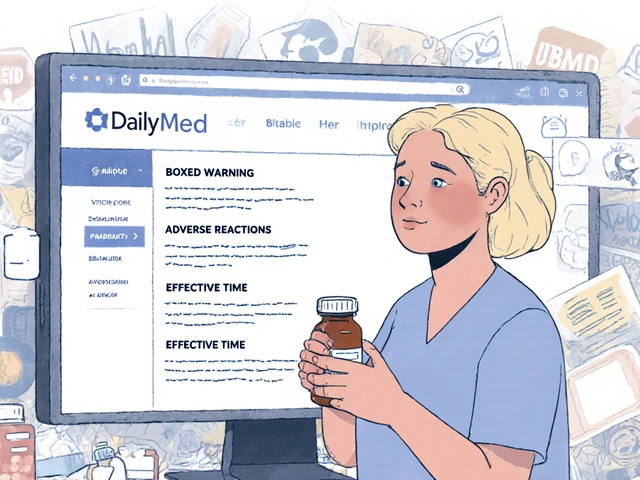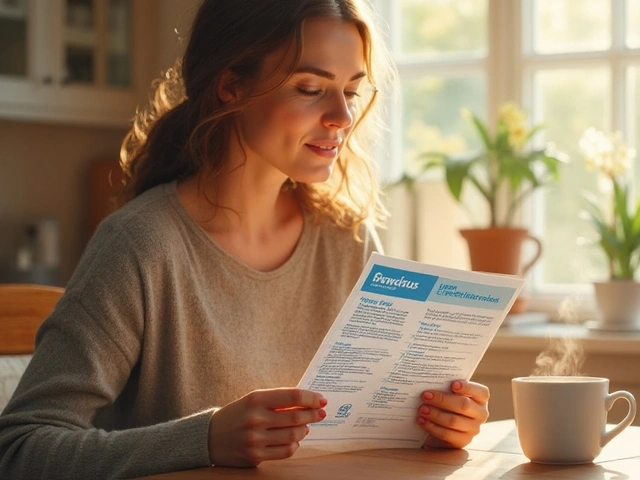Carbamazepine Dosing Calculator for Older Adults
Dosing Guidelines
- Target range for seniors: 4-6 µg/mL
- Caution: Avoid doses > 400 mg daily without monitoring
- Check levels: 12 hours after last dose (trough level)
When a doctor prescribes carbamazepine to someone over 65, the decision feels heavier than handing over a simple pill. Older bodies process drugs differently, and the line between benefit and harm can shift fast. This guide walks you through why carbamazepine is still chosen for seniors, how to dose it safely, and what warnings to keep an eye on.
What is carbamazepine and how does it work?
Carbamazepine is a synthetic anticonvulsant that stabilizes hyper‑excited neuronal membranes by blocking voltage‑gated sodium channels. It was first approved in 1968 and has since become a staple for several neurologic and psychiatric conditions. By slowing the rapid firing of neurons, it raises the seizure threshold and also dampens mood swings in bipolar disorder.
Why consider carbamazepine for older adults?
Even with newer drugs on the market, carbamazepine remains a go‑to for two main reasons:
- Epilepsy in the elderly often presents as focal seizures, and carbamazepine has strong evidence for controlling these.
- For Bipolar Disorder, especially when mood stabilizers like lithium pose kidney concerns, carbamazepine offers an alternative with a different side‑effect profile.
However, age‑related changes in metabolism mean the drug’s concentration can climb quickly, so clinicians must tailor the regimen.
Dosing basics for seniors
Geriatric pharmacokinetics demand a "start low, go slow" approach. Here’s a step‑by‑step plan many neurologists follow:
- Begin with 100 mg once daily - half the adult starter dose.
- Increase by 100 mg every 5‑7 days only if serum levels stay below 6 µg/mL and no side effects emerge.
- Target maintenance range for older adults is 4-6 µg/mL; many stay well‑controlled at 200-400 mg total daily dose.
Key physiological factors to watch:
- Liver Metabolism slows with age, reducing the conversion of carbamazepine to its active epoxide.
- Renal Clearance also declines, impacting the excretion of metabolites.
- Changes in plasma protein binding increase the free (active) fraction of the drug.
Side‑effects that matter most in the elderly
Older patients report two clusters of adverse events more often than younger groups:
- Hyponatremia - low sodium can cause confusion, falls, and seizures. Serum sodium below 130 mmol/L warrants dose reduction or drug discontinuation.
- Cognitive decline - slowed thinking, memory lapses, and drowsiness become noticeable after a few weeks. If daily living suffers, consider a switch.
Less common but serious reactions include Stevens‑Johnson syndrome, agranulocytosis, and severe rash. Routine blood counts every 3 months help catch early marrow suppression.
Drug interactions you can’t ignore
Polypharmacy is the norm for seniors. Carbamazepine is a potent inducer of CYP3A4, meaning it can lower the effectiveness of many co‑prescribed meds:
- Warfarin - increased clearance may require higher INR targets.
- Statins such as simvastatin - reduced lipid‑lowering effect.
- Oral contraceptives - decreased hormone levels, though less relevant for most older adults.
Conversely, drugs that inhibit CYP3A4 (e.g., clarithromycin, fluconazole) can push carbamazepine levels into toxicity. Always double‑check the interaction checker before adding a new prescription.
Therapeutic drug monitoring (TDM)
Because the therapeutic window narrows with age, measuring serum levels is standard practice. Here’s a quick reminder:
- Draw blood 12 hours after the last dose (trough level).
- Desired range for older adults: 4-6 µg/mL.
- If levels rise above 8 µg/mL, reduce the dose by 25 % and reassess side‑effects.
Combine TDM with regular checks of sodium, liver enzymes, and CBC to stay ahead of problems.
Alternatives: When to consider a switch?
If carbamazepine’s side‑effect profile becomes untenable, other options exist. Below is a side‑by‑side look at three common alternatives for elderly patients.
| Drug | Typical Dose (Elderly) | Key Advantage | Major Concern |
|---|---|---|---|
| Carbamazepine | 200‑400 mg/day | Proven efficacy for focal seizures | Hyponatremia, drug interactions |
| Levetiracetam | 500‑1500 mg/day | Minimal CYP involvement | Behavioral irritability |
| Lamotrigine | 25‑100 mg/day | Low risk of hyponatremia | Slow titration required |
| Valproate | 250‑750 mg/day | Broad spectrum | Hepatotoxicity, thrombocytopenia |
Pick an alternative when the risk‑benefit calculus tips toward safety-particularly in patients with a history of electrolyte disturbances or those on multiple CYP3A4 substrates.
Practical checklist for clinicians and caregivers
- Confirm indication (focal epilepsy, bipolar, trigeminal neuralgia).
- Start at 100 mg once daily; schedule follow‑up in 1 week.
- Order baseline labs: CBC, LFTs, electrolytes, and serum carbamazepine level.
- Review all current meds for CYP3A4 interactions.
- Educate patient/caregiver about signs of hyponatremia (nausea, headache, confusion).
- Schedule TDM after steady state (≈5 days) and again after any dose change.
- Re‑evaluate every 3‑6 months; adjust dose based on level, side‑effects, and seizure control.
Following this routine reduces emergency visits and keeps quality of life high.
Bottom line
Carbamazepine can still be a solid choice for older adults, but it demands vigilant dosing, routine labs, and a clear eye on drug‑drug interactions. When the balance tips toward toxicity, alternatives like levetiracetam or lamotrigine often provide smoother sailing.
What makes carbamazepine risky for seniors?
Age‑related liver slowdown, the drug’s ability to lower sodium, and its strong influence on many other medications combine to raise the odds of side‑effects in people over 65.
How often should serum carbamazepine levels be checked?
Check a trough level after reaching a steady dose (about 5 days), then repeat every 3 months or whenever the dose changes or new drugs are added.
Can carbamazepine cause dementia‑like symptoms?
High concentrations can lead to cognitive slowing and memory lapses, which may mimic early dementia. Adjusting the dose or switching drugs usually reverses these changes.
Is hyponatremia more common with carbamazepine than with other antiepileptics?
Yes. Carbamazepine triggers the syndrome of inappropriate antidiuretic hormone secretion more often than newer agents, so regular sodium checks are essential.
When should a clinician consider switching from carbamazepine to levetiracetam?
If the patient develops persistent hyponatremia, significant drug interactions, or intolerable side‑effects, levetiracetam’s minimal CYP involvement makes it a safer alternative.




Craig E
October 22, 2025 AT 12:26One must view carbamazepine not merely as a pill, but as a bridge between neurological stability and the dignity of aging. The “start low, go slow” mantra resonates with the philosophical principle of moderation, reminding us that excess, even in therapy, can erode the very balance we seek. By monitoring serum levels and sodium diligently, clinicians honor the patient’s autonomy while safeguarding against preventable harm. In practice, a 100 mg initiation, coupled with weekly reassessment, embodies this harmonious approach.
Marrisa Moccasin
October 22, 2025 AT 13:50But what if the very labs we trust are part of a larger scheme, a hidden agenda, orchestrated by pharmaceutical giants to keep us dependent?! The mandatory trough level draws blood, yet the data often disappears into opaque databases, feeding algorithms that decide who gets more medication, who gets less-are we mere pawns in their profit‑driven chess game??
Taylor Haven
October 22, 2025 AT 15:13It is incumbent upon us, as stewards of public health, to recognize that prescribing carbamazepine to seniors is not a neutral act but a moral decision weighted with responsibility. When a practitioner chooses this drug, they implicitly endorse a risk profile that includes hyponatremia, cognitive blunting, and a cascade of drug‑drug interactions that can destabilize fragile polypharmacy regimens. This is not merely a clinical nuance; it is an ethical crossroads where beneficence must be weighed against non‑maleficence with rigorous scrutiny. The elderly population, already vulnerable to medication‑induced delirium, deserves a therapeutic plan that minimizes iatrogenic harm. Therefore, any initiation should be accompanied by a comprehensive review of all concurrent medications, with particular attention to CYP3A4 substrates that could be rendered ineffective. Moreover, clinicians must insist on baseline sodium and liver enzyme panels before the first dose, reinforcing that vigilance begins at day zero. Subsequent monitoring should be scheduled at regular intervals-every three months for serum carbamazepine levels, and more frequently if the patient exhibits signs of confusion or falls. The literature consistently demonstrates that serum concentrations above 8 µg/mL dramatically increase the likelihood of adverse cognitive effects, a threshold that should trigger an immediate dose reduction. In addition, the phenomenon of syndrome of inappropriate antidiuretic hormone secretion is not incidental; it is a predictable pharmacodynamic consequence that mandates proactive sodium surveillance. If hyponatremia is detected, the clinician must act decisively-either by dose tapering or by substituting an alternative antiepileptic with a lower propensity for electrolyte disturbance. From an ethical standpoint, the principle of respect for patient autonomy also obliges us to educate patients and caregivers about the subtle signs of toxicity, such as nausea, headache, or subtle memory lapses, which can otherwise be dismissed as “normal aging.” By fostering informed consent, we empower seniors to participate actively in their own care, thereby aligning treatment with their values and preferences. Lastly, the decision to continue carbamazepine must be revisited periodically, recognizing that the risk‑benefit calculus evolves as the patient’s comorbidities and medication list change over time. In sum, the prescription of carbamazepine for older adults demands a disciplined, ethically grounded protocol that prioritizes safety, transparency, and continual reassessment.
Sireesh Kumar
October 22, 2025 AT 16:36Listen, the drama isn’t just in the labs; it’s in the day‑to‑day reality of a senior juggling a dozen prescriptions while trying to enjoy a cup of tea. You might think the numbers speak for themselves, but what about the lived experience-drowsiness that makes a morning crossword impossible, or the sudden drop in sodium that turns a routine walk into a tumble? My patients often tell me they feel like their mind is foggy after a week on carbamazepine, and that fog can be the difference between staying independent and moving into assisted living. It’s not just about hitting target trough levels; it’s about preserving quality of life, which, frankly, gets lost in the clinical checklist.
Jonathan Harmeling
October 22, 2025 AT 18:00While the data underscore the importance of careful titration, we must also remember the human element-each dose adjustment affects a person’s daily rhythm, sleep patterns, and emotional steadiness. A nuanced approach that blends quantitative monitoring with qualitative feedback from caregivers can bridge the gap between numbers and lived wellbeing.
Ritik Chaurasia
October 22, 2025 AT 19:23In many cultures, elders are revered as pillars of wisdom, and subjecting them to a drug that can sap cognition is tantamount to disrespect. The aggressive metabolism of carbamazepine in older bodies should compel us to explore alternatives that honor their mental clarity and societal role, not undermine it with avoidable side‑effects.
Holly Green
October 22, 2025 AT 20:46From a practical standpoint, the checklist you outlined hits all the right notes-start low, monitor labs, and educate caregivers. It’s a solid roadmap for keeping seniors safe while they stay on carbamazepine.
Mary Keenan
October 22, 2025 AT 22:10Enough with the checklist; real life is messier.
Steven Young
October 22, 2025 AT 23:33Some of us suspect that the push for routine carbamazepine monitoring is less about patient safety and more about creating a data stream for undisclosed research. The guidelines may mask an agenda to collect serum levels that feed corporate algorithms without our consent
Kelly Brammer
October 23, 2025 AT 00:56The ethical duty of clinicians is to prioritize transparent care over hidden data collection, ensuring that any monitoring serves the patient’s health first and foremost.